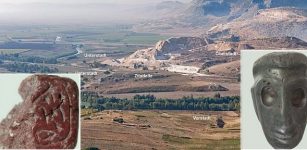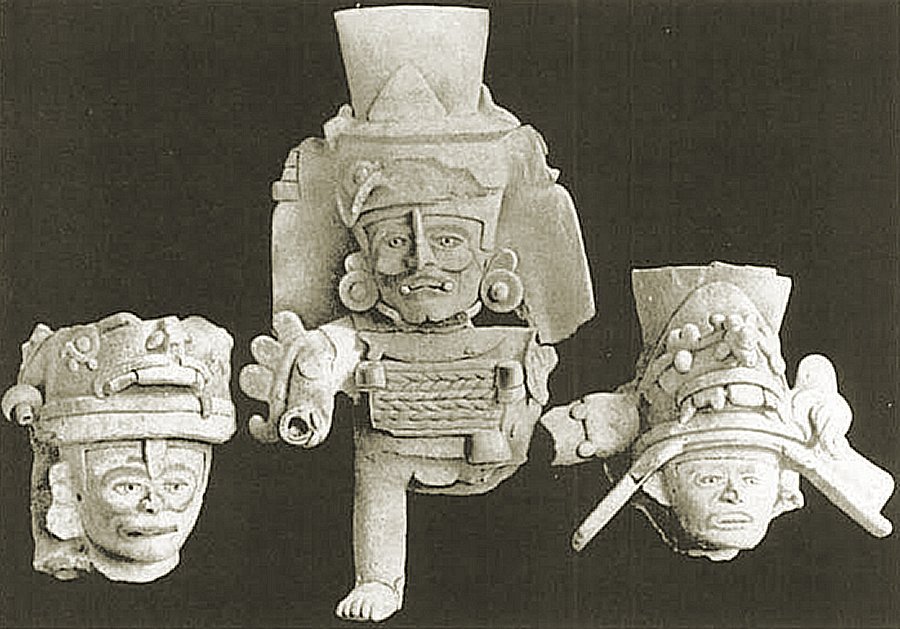Rise Of League Of Mayapán And The Last Great Maya Capital
A. Sutherland - AncientPages.com - According to the Book of Chilam Balam of Chumayel, Hunac Ceel, ruler of Mayapan, conquered Chichén Itzá in the 13th century. Archaeological data, on the other hand, indicates that Chichén Itzá declined as a regional center by 1250, before the rise of Mayapan.
Ruins of the last great city of the Maya – Mayapan. Images credit: Yucatan Gobierno del Estado
Earlier, from the 10th through the 12th century, Chichén Itzá, Uxmal, and Mayapan (means "The Flag or the Banner of the Mayas"), were the three most important and powerful ceremonial centers. Towards the year 1194, the political situation changed and Mayapán took the power from Chichén Itzá and managed to retain it until 1441. The fall of Chichén Itzá initiated two significant events in the history of Yucatán,
- the rise of the city-state of Mayapán, a new capital of the Maya civilization, established c.1263 and 1283 AD and
- the formation of the alliance of Yucatec rulers known as the League of Mayapán.
The League formed by the chieftains of Mayapán, Uxmal, and Chichén Itzá began successfully control the region until 1450 AD. However, not all people were satisfied. The League had many opponents among the inhabitants of the other Mayan kingdoms of the Peninsula.
Nobles were forced to live within the defensive walls of the city so their kingdoms had no choice but to stay loyal to the League.
“Mayapán ruled over a large territory in Yucatan. This realm was divided into provinces that were administered as a confederacy under Mayapán’s control. Each province (kuchcabal) was ruled from a prominent town…. They built houses for the lords only, dividing all the land among them, giving towns to each other…. The leaders of these subordinate towns lived in Mayapán, supported by their subjects, “where each lord could keep servants…” according to Bishop Landa’s 16th-century description.
By residing in the capital, these subordinate lords could be closely monitored by Mayapan’s rulers and it was life in captivity.
Around 1440 – 1450 AD, the people who lived in captivity started rebelling against the rule of Mayapán. The League began to decline and by 1461 it was completely disintegrated. The city of Mayapan was burned and abandoned.
City Of Mayapán Resembled Chichén Itzá
Today, the walled city of Mayapán, (known as "Flag of the Mayas"), is considered the last great Mayan capital. It was built in the likeness of Chichén Itzá. At its peak, Mayapán was the most important city but its population was only 15,000 and it covered an area of only 4.2 square kilometers (1.6 miles).
Mayapán-style ceramic idols represent images of gods and were used by the Maya for burning incense. Image credit: Thomas Gann, 1900
About 10-12,000 people lived within the walled city of Mayapán, surrounded by a 9.1 km long and roughly ovate wall.
Archaeological excavations revealed the city’s ceremonial center (constructed in the style of that in Chichén Itzá), tightly packed with about 4,000 functioning structures displaying architecture similar to that of Chichén Itzá.
Among the ruins of Mayapán are temples, shrines, altars, platforms, sanctuaries, colonnaded halls, oratories, and feathered serpent columns.
Sculptures, depicting human portraits, feline figures, turtles, serpents, diving figures, and various stelae richly decorate Mayapán’s ceremonial buildings. Archaeological diggings revealed evidence for captive sacrifice at Mayapán, where altars - similar to those used at Chichen Itza – were used for heart excision. Other evidence shows the bones of human sacrifices including some that had been decapitated.
The city’s main temple is the Temple of Kukulkan, a large four-sided and 15 meter-high pyramid known as the Castillo. It is very similar and yet inferior to that of Chichen Itza.
However, an interesting spectacular phenomenon of light and shadow during the winter solstice (December 21) is identical to that experienced at Chichen Itza.
Written by – A. Sutherland AncientPages.com Staff Writer
Copyright © AncientPages.com All rights reserved. This material may not be published, broadcast, rewritten or redistributed in whole or part without the express written permission of AncientPages.com
Expand for referencesReferences:
Foster L V. Handbook to Life in the Ancient Maya World
Sharer R. J. Traxler L.P. The Ancient Maya
More From Ancient Pages
-
 Oldest Evidence To Date: 80,000-Year-Old Stone Blades Of Homo Sapiens Found In Jebel Faya, Arabia
Archaeology | Feb 19, 2025
Oldest Evidence To Date: 80,000-Year-Old Stone Blades Of Homo Sapiens Found In Jebel Faya, Arabia
Archaeology | Feb 19, 2025 -
 Unsolved Mystery Of The Huldremose Woman: One Of The Best Preserved Bog Bodies Ever Found
Civilizations | Jan 9, 2017
Unsolved Mystery Of The Huldremose Woman: One Of The Best Preserved Bog Bodies Ever Found
Civilizations | Jan 9, 2017 -
 Ancient Burial Of A Princess Who Fell Off A Cliff Raises Many Questions
Archaeology | Apr 18, 2019
Ancient Burial Of A Princess Who Fell Off A Cliff Raises Many Questions
Archaeology | Apr 18, 2019 -
 Has a 2,000 Year Old Podium Been Found in the City of David?
Civilizations | Sep 2, 2015
Has a 2,000 Year Old Podium Been Found in the City of David?
Civilizations | Sep 2, 2015 -
 Radar Reveals ‘Ghost’ Footprints From Pleistocene Era
Archaeology | Nov 13, 2019
Radar Reveals ‘Ghost’ Footprints From Pleistocene Era
Archaeology | Nov 13, 2019 -
 First Scandinavian farmers were far more advanced than previously thought
News | Aug 23, 2015
First Scandinavian farmers were far more advanced than previously thought
News | Aug 23, 2015 -
 Nebiri, a ‘Chief of Stables’ – oldest case of heart disease in 3,500-year-old mummy
News | Aug 28, 2015
Nebiri, a ‘Chief of Stables’ – oldest case of heart disease in 3,500-year-old mummy
News | Aug 28, 2015 -
 Artifacts And Long History Of Unguja Island – Ancient Humans Impact Island’s Environment
Archaeology | Mar 5, 2022
Artifacts And Long History Of Unguja Island – Ancient Humans Impact Island’s Environment
Archaeology | Mar 5, 2022 -
 Mysterious Mount Kailash: Secrets Of The Man-Made Pyramid And Entrance To The City Of The Gods
Ancient Mysteries | Oct 27, 2014
Mysterious Mount Kailash: Secrets Of The Man-Made Pyramid And Entrance To The City Of The Gods
Ancient Mysteries | Oct 27, 2014 -
 Bronze Age And Iron Age City Complex Once Known As Kummanni Unearthed In Turkey
Archaeology | Dec 4, 2018
Bronze Age And Iron Age City Complex Once Known As Kummanni Unearthed In Turkey
Archaeology | Dec 4, 2018 -
 Why Are The 2,000-Year-Old Roman Walls Found In Switzerland An ‘Archaeological Sensation’?
Archaeology | Sep 15, 2023
Why Are The 2,000-Year-Old Roman Walls Found In Switzerland An ‘Archaeological Sensation’?
Archaeology | Sep 15, 2023 -
 Non-Tobacco Plant Identified In Ancient Pipe Using New Technology
Archaeology | Jun 30, 2020
Non-Tobacco Plant Identified In Ancient Pipe Using New Technology
Archaeology | Jun 30, 2020 -
 Battle Of Abrittus: Roman Emperor Decius And His Troops Ambushed And Defeated By Invading Goths
Featured Stories | Jul 1, 2019
Battle Of Abrittus: Roman Emperor Decius And His Troops Ambushed And Defeated By Invading Goths
Featured Stories | Jul 1, 2019 -
 Mysterious Mermaid Mummy Investigated By Scientists
News | Feb 22, 2022
Mysterious Mermaid Mummy Investigated By Scientists
News | Feb 22, 2022 -
 Magnificent Reconstruction Of Scotland’s Largest Pictish Fort Burghead
Archaeology | Nov 3, 2021
Magnificent Reconstruction Of Scotland’s Largest Pictish Fort Burghead
Archaeology | Nov 3, 2021 -
 On This Day In History: Storming Of The Paris Fortress – Prison Bastille – On July 14, 1789
News | Jul 14, 2016
On This Day In History: Storming Of The Paris Fortress – Prison Bastille – On July 14, 1789
News | Jul 14, 2016 -
 Green Comet Last Seen By The Neanderthals 50,000 Years Ago May Be Visible To The Naked Eye This Week
Archaeoastronomy | Jan 9, 2023
Green Comet Last Seen By The Neanderthals 50,000 Years Ago May Be Visible To The Naked Eye This Week
Archaeoastronomy | Jan 9, 2023 -
 Mysterious Ancient Grave With Unusual Artifacts That Belonged To A Völva – Norse Female Shamans Did Exist
Featured Stories | Jul 2, 2017
Mysterious Ancient Grave With Unusual Artifacts That Belonged To A Völva – Norse Female Shamans Did Exist
Featured Stories | Jul 2, 2017 -
 Hydra Greek Monster: Fearsome Multi-Headed Dragon That Inhabited Swamps Of Lerna
Featured Stories | Sep 20, 2019
Hydra Greek Monster: Fearsome Multi-Headed Dragon That Inhabited Swamps Of Lerna
Featured Stories | Sep 20, 2019 -
 17th Century Medical Pop-Up Book Digitized
Archaeology | Jan 16, 2016
17th Century Medical Pop-Up Book Digitized
Archaeology | Jan 16, 2016





